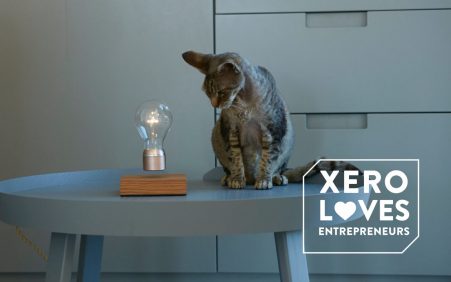
This startup shares how they use beautiful design in everything they do

To celebrate Global Entrepreneurship Week, we asked our small business customers from all over the world to share the highs and lows of their experience with aspiring entrepreneurs of the future. Today, we hear from Simon Morris and Chris Higham, co-founders of Flyte.
The first time people see Flyte’s hovering light bulb, the response is typically awe and wonder. It’s one of a trio of products the company has released, all powered by magnetic levitation.
Simon and Chris recently sat down with Xero to talk about how Flyte uses beautiful design in everything they do, even their accounting.
Kicking their Kickstarter goals
In 2015, Simon, Chris and third Flyte Co-Founder and CMO, Daniel Mascarenhas, had their light bulb, but they needed to find a way to bring it to market. That’s when they decided they’d give crowdfunding a try.
“When we launched the first Kickstarter we had no idea what to expect, we were very down and out and weren’t working a lot,” Simon remembers.
By the time the campaign ended, they had raised nearly eight times their goal. It was then that they realized it was more than just a basement operation — they had a business on their hands.
Today, they’re on Kickstarter number three — a levitating timepiece — it’s their third product to be overfunded. It’s clear that the ‘wow’ factor has been a huge part of their success, which Simon says lies in its simplicity.
“It looks simple and direct from the outside — even though it isn’t — and it doesn’t require any real explanation,” Simon says.
“When you create a product that speaks for itself and creates joy, you’re onto something.”
Power to the people
Circumventing traditional means of funding, Simon explains they’ve chosen Kickstarter again and again because of the power of it; if you have an idea, you can easily share it with people.
“I love the idea that the people themselves, and the power of the internet, can give leverage to someone’s idea,” Simon says.
“It doesn’t even have to be a hugely original idea, but the creators are able to experience of a lot of success this way. It’s like the golden age of entrepreneurship.”
Simon says the secret to a successful Kickstarter, which may look easy from the outside, is a lot of preparation.
“It’s about creating a good story. If you have great idea, you need to package it well and make sure people resonate with it,” Simon explains.
“You need to contact journalists weeks in advance. We’ve had a party the day of each launch with friends and got them involved.”
“Enough people can grassroots spread the word.”
Too much of a good thing
On the flipside, Simon says they’ve learned from mistakes made in previous campaigns and how to structure them so as to not promise unrealistic delivery dates.
“Being realistic about delivery dates and product features is important. We try to incorporate a lot of amazing ideas from our customers, but doing all of them would take years,” Chris says.
Simon estimates that the average crowdfunded product can take about eight months from start to finish to get out to the backers. While you often hear about crowdfunding success stories – getting overfunded isn’t necessarily always a good thing.
“We’ve been on time, fortunately. It’s really challenging because there’s so many unknowns,” Simon says.
“It’s important to go at the pace that feels comfortable. If you raise too many funds and scale out of proportion, it could set your release date back months.”
“Keep your backers informed always. Tell them about obstacles, the biggest mistake is not communicating to your backers.”
Beautiful product, beautiful accounting software
Simon said shortly after their unexpectedly successful first Kickstarter campaign, they implemented Xero.
“We like Xero as designers and people who like to innovate,” Simon says.
“Often technology companies underestimate UI and think they’ll do it their way and make the customer adapt.”
“What I found interesting is that it’s very intuitive and easy-to-use.”
The didn’t have an accountant when they first implemented Xero, but Simon says as their financials got more complex they hired one.
Today, with various b2b distribution agreements and an online store, Flyte uses invoicing and processes payments through Shopify, Stripe and PayPal. Simon says now that they’re leveraging these payment processing tools and their direct integrations with Xero, they’re key to getting a grasp of their cash flow. He loves that it all happens automatically.
“The faster we’re in and out the better, so we can focus on our core skills,” Simon says.
At the end of the day, Simon says the team at Flyte just wants to inspire people to do different things.
“We like to create and have fun — the success of our campaigns have been just a bonus.”
“So far so good.”
The post This startup shares how they use beautiful design in everything they do appeared first on Xero Blog.
Source: Xero Blog






